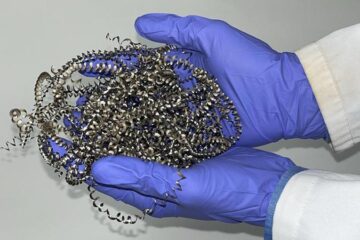Probing the nanoparticle: Predicting how nanoparticles will react in the human body

NC State researchers Dr. Jim Riviere, Burroughs Wellcome Distinguished Professor of Pharmacology and director of the university's Center for Chemical Toxicology Research and Pharmacokinetics, Dr. Nancy Monteiro-Riviere, professor of investigative dermatology and toxicology, and Dr. Xin-Rui Xia, research assistant professor of pharmacology, wanted to create a method for the biological characterization of nanoparticles – a screening tool that would allow other scientists to see how various nanoparticles might react when inside the body.
“We wanted to find a good, biologically relevant way to determine how nanomaterials react with cells,” Riviere says. “When a nanomaterial enters the human body, it immediately binds to various proteins and amino acids. The molecules a particle binds with will determine where it will go.”
This binding process also affects the particle's behavior inside the body. According to Monteiro-Riviere, the amino acids and proteins that coat a nanoparticle change its shape and surface properties, potentially enhancing or reducing characteristics like toxicity or, in medical applications, the particle's ability to deliver drugs to targeted cells.
To create their screening tool, the team utilized a series of chemicals to probe the surfaces of various nanoparticles, using techniques previously developed by Xia. A nanoparticle's size and surface characteristics determine the kinds of materials with which it will bond. Once the size and surface characteristics are known, the researchers can then create “fingerprints” that identify the ways that a particular particle will interact with biological molecules. These fingerprints allow them to predict how that nanoparticle might behave once inside the body.
The study results appear in the Aug. 23 online edition of Nature Nanotechnology.
“This information will allow us to predict where a particular nanomaterial will end up in the human body, and whether or not it will be taken up by certain cells,” Riviere adds. “That in turn will give us a better idea of which nanoparticles may be useful for drug delivery, and which ones may be hazardous to humans or the environment.”
The Center for Chemical Toxicology Research and Pharmacokinetics is part of NC State's College of Veterinary Medicine. The research was funded by the Environmental Protection Agency and the U.S. Air Force Office of Scientific Research.
Note to editors: An abstract of the paper follows
“An index for characterization of nanomaterials in biological systems”
Authors: Xin-Rui Xia, Nancy A. Monteiro-Riviere and Jim E. Riviere, NC State University
Published: Online in Aug. 15, 2010, Nature Nanotechnology
Abstract: In a physiological environment, nanoparticles selectively absorb proteins to form 'nanoparticle—protein coronas', a process governed by molecular interactions between chemical groups on the nanoparticle surfaces and the amino-acid residues of the proteins. Here, we propose a biological surface adsorption index to characterize these interactions by quantifying the competitive adsorption of a set of small molecule probes onto the nanoparticles. The adsorption properties of nanomaterials are assumed to be governed by Coulomb forces, London dispersion, hydrogen-bond acidity and basicity, polarizability and lone-pair electrons. Adsorption coefficients of the probe compounds were measured and used to create a set of nanodescriptors representing the contributions and relative strengths of each molecular interaction. The method successfully predicted the adsorption of various small molecules onto carbon nanotubes, and the nanodescriptors were also measured for 12 other nanomaterials. The biological surface adsorption index nanodescriptors can be used to develop pharmacokinetic and safety assessment models for nanomaterials.
Media Contact
More Information:
http://www.ncsu.eduAll latest news from the category: Life Sciences and Chemistry
Articles and reports from the Life Sciences and chemistry area deal with applied and basic research into modern biology, chemistry and human medicine.
Valuable information can be found on a range of life sciences fields including bacteriology, biochemistry, bionics, bioinformatics, biophysics, biotechnology, genetics, geobotany, human biology, marine biology, microbiology, molecular biology, cellular biology, zoology, bioinorganic chemistry, microchemistry and environmental chemistry.
Newest articles

“Nanostitches” enable lighter and tougher composite materials
In research that may lead to next-generation airplanes and spacecraft, MIT engineers used carbon nanotubes to prevent cracking in multilayered composites. To save on fuel and reduce aircraft emissions, engineers…

Trash to treasure
Researchers turn metal waste into catalyst for hydrogen. Scientists have found a way to transform metal waste into a highly efficient catalyst to make hydrogen from water, a discovery that…

Real-time detection of infectious disease viruses
… by searching for molecular fingerprinting. A research team consisting of Professor Kyoung-Duck Park and Taeyoung Moon and Huitae Joo, PhD candidates, from the Department of Physics at Pohang University…





















